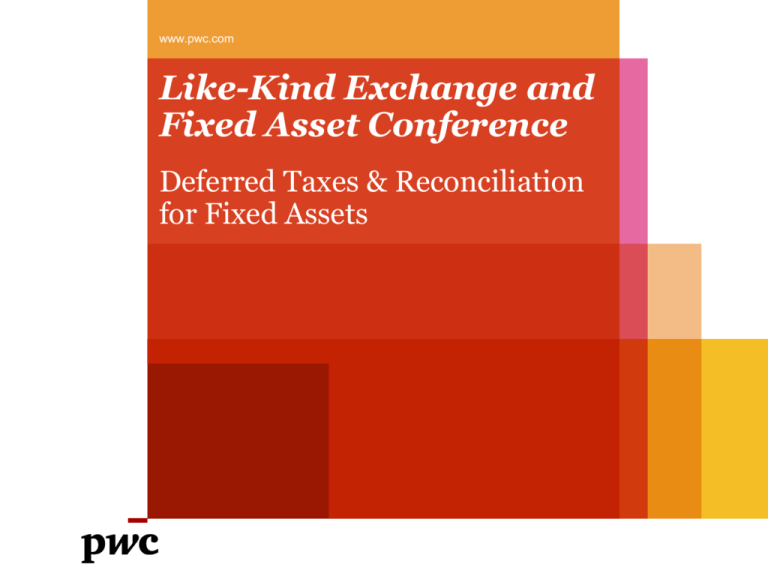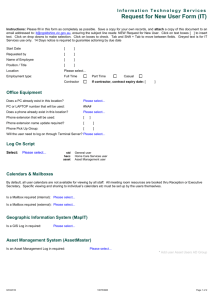
www.pwc.com
Like-Kind Exchange and
Fixed Asset Conference
Deferred Taxes & Reconciliation
for Fixed Assets
Overview
•
•
•
•
•
•
•
•
•
Deferred tax reconciliation overview
Important considerations to remediating differences
How do book & tax fixed assets become misaligned?
Fixed asset rollforward process
Coordinating book & tax fixed asset functions
Fixed asset system issues
Example of items with book/tax differences
Tracking adjustments off-line
Best practices
This document was not intended or written to be used, and it cannot be
used, for the purpose of avoiding US, Federal, State, or local tax penalties
Like-Kind Exchange and Fixed Asset Conference
PwC
May 10, 2012
Slide 2
Deferred Tax Reconciliation Overview
• Reconciling the Deferred Tax Asset (DTA) or Deferred Tax Liability
(DTL) for fixed assets includes the following:
- NBV vs. NTV of the fixed assets = DTA/(DTL) based on asset detail
- Cumulative Schedule M relating to fixed assets
• Compare the two amounts to determine if DTA/(DTL) are in-line
Like-Kind Exchange and Fixed Asset Conference
PwC
May 10, 2012
3
Important Considerations for Remediation
•
•
•
•
•
•
Sarbanes Oxley – Section 404 control issues
IRS exam exposure
FIN 48 considerations
Accounting method options – Automatic vs. Non Automatic
Amended tax returns
Coordination with other functional areas – Finance / Property Acctg.
Like-Kind Exchange and Fixed Asset Conference
PwC
May 10, 2012
Slide 2
How do Book and Tax Fixed Assets Become
Misaligned?
• Missing or flawed rollforward process
• Separation of book and tax fixed asset management function
• Fixed asset systems issues
• Fixed asset system migrations and ERP implementations
• Transactions with book/tax differences
• Offline tracking of book/tax topside adjustments
Like-Kind Exchange and Fixed Asset Conference
PwC
May 10, 2012
5
The Rollforward Process
• Reconciliation of book and tax subledger activity for cost and A/D
• Identification and explanation of differences in book and tax cost
activity
• Reconciliation of book subledger activity to general ledger
◦ Identify topside entries made at the G/L level
◦ Reconcile balance sheet activity to P&L (depr. exp., gain/loss)
• Reconciliation of tax subledger activity to tax return
◦ Identify and ensure appropriate inclusion of offline adjustments
◦ Ensure appropriate adjustments to basis are reflected (Sections
168(k), 174, 179D, and 48 credits/grants, etc.)
Like-Kind Exchange and Fixed Asset Conference
PwC
May 10, 2012
6
Sample Rollforward
Book
Cost
Company
Co. 1001
Co. 1002
Co. 1003
Co. 1004
Co. 1005
Tax
Total
Company
Co. 1001
Co. 1002
Co. 1003
Co. 1004
Co. 1005
Total
Difference
Accumulated Depreciation
DTA/(DTL)
Beg. Balance
100,000
50,000
20,000
15,000
10,000
Additions
100,000
Disposals
(150,000)
Other
Ending Balance
50,000
50,000
20,000
15,000
10,000
Beg. Balance
(20,000)
(10,000)
(4,000)
(3,000)
(2,000)
Depr Exp.
(20,000)
(10,000)
(4,000)
(3,000)
(2,000)
Disposals
15,000
-
Other
-
Ending Balance
(25,000)
(20,000)
(8,000)
(6,000)
(4,000)
195,000
100,000
(150,000)
-
145,000
(39,000)
(39,000)
15,000
-
(63,000)
Beg. Balance
100,000
50,000
20,000
15,000
10,000
Additions
50,000
Disposals
(30,000)
Other
Ending Balance
120,000
50,000
20,000
15,000
10,000
Beg. Balance
(35,000)
(17,500)
(7,000)
(5,250)
(3,500)
Depr Exp.
(40,000)
(20,000)
(8,000)
(6,000)
(4,000)
Disposals
10,000
-
Other
-
Ending Balance
(65,000)
(37,500)
(15,000)
(11,250)
(7,500)
195,000
50,000
(30,000)
-
215,000
(68,250)
(78,000)
10,000
-
(136,250)
78,750
(50,000)
120,000
-
70,000
(29,250)
(39,000)
(5,000)
-
(73,250)
(3,250)
-
Ties to 174
M-1
Ties to G/L
M-1
Reconciles to
Depr. M-1
Reconciles to
G/L M-1
Def. Tax Reconciliation DTA/(DTL)
Beg. Balance
Curr. Depr M-1
Curr. G/L M-1
174 Deduction
End. Balance
Per Subledger
Difference
(29,250)
(39,000) Ties to return
115,000 Ties to return
(50,000) Ties to return
(3,250)
(3,250)
-
Like-Kind Exchange and Fixed Asset Conference
PwC
May 10, 2012
Page 7
(82,000)
The Importance of Coordinated Book and Tax
Fixed Asset Management Function
• Left hand doesn’t know what right hand is doing = trouble!
• Book entries impacting tax may not be properly or timely
communicated – examples include:
◦ Intercompany transfers
◦ Book write down and impairment charges
◦ Assets Held for Sale
◦ SFAS 143 accounting
• Efficiency gained by having book and tax fixed asset management
function combined or robustly integrated
Like-Kind Exchange and Fixed Asset Conference
PwC
May 10, 2012
Page 8
Fixed Asset Systems Issues
• Separate book and tax systems may result in duplicated efforts,
additional reconciliation, and missed transactions
• So, why would a company have separate book and tax fixed asset
systems?
◦ Many ERP systems require significant customization for tax and
ongoing tax legislative changes
◦ Separated book and tax fixed asset processes
• “Our system couldn’t handle it” – results in topside adjustments
Like-Kind Exchange and Fixed Asset Conference
PwC
May 10, 2012
Page 9
Common Examples of Items with Book-Tax
Differences
Item
Considerations
Sale-Leaseback Transactions
May have differing book and tax treatment such as
the recognition of gain/loss and subsequent
treatment of leased property as either capital or
operating.
Impairments
The impairment charges to cost may be
erroneously applied to the tax assets resulting in
understated tax basis.
Transfers to/from other entities
For book purposes, transfers between entities
within the same tax consolidated group may be
treated as a sale and repurchase resulting in the
recording of a new asset at FMV. However, for
federal tax purposes, no gain/loss should be
recognized and the carryover basis in the asset
should move to the new entity.
Site Investigatory Costs
Certain investigatoty costs are deductible for tax
purposes, but must be capitalized for book
purposes.
Like-Kind Exchange and Fixed Asset Conference
PwC
May 10, 2012
Page 10
Common Examples of Items with Book-Tax
Differences - Continued
Item
Cost Segregation Studies
Repair and Maintenance Studies
Capitalized Interest
Business Acquisition Property
Like-Kind Exchange and Fixed Asset Conference
PwC
Considerations
Often times cost segregation study adjustments
are tracked offline. These adjustments are
sometimes overlooked resulting in incorrect tax
return reporting. Additionally, these adjustments
can be overlooked when calculating the gain/loss
on sales of assets.
For tax purposes, certain capital expenditures are
deductible Section 162 costs, but capitalizable
fixed assets for book purposes resulting in
book:tax cost basis differences. The opposite is
also true where certain costs are deductible for
book purposes but require capitalization for tax
purposes.
Differences between book and tax 263A capitalized
interest
Stock acquisitions without a Section 338(h)(10)
election require that assets use historical cost and
A/D, while the assets are capitalized at FMV for
book purposes.
May 10, 2012
Page 11
Common Examples of Items with Book-Tax
Differences - Continued
Item
Section 174 Software Costs
Construction Allowances/Tenant Improvements
Assets Held for Sale
Section 48 Grant Property
Like-Kind Exchange and Fixed Asset Conference
PwC
Considerations
The election to currently deduct qualified Section
174 property results in a book:tax difference in
basis of fixed assets and may also result in a
book:tax cost difference in CIP prior to the placingin-service of the property.
Under GAAP accounting, construction allowances
are recorded in a deferred income account that is
amortized over the life of the lease. For tax
purposes, IRC Section 110 and certain other
tenant allowances are recorded as a reduction to
the cost basis of the underlying assets.
For book purposes, assets deemed held for sale
are reclassed from depreciable fixed assets to a
held for sale account. For tax purposes, these
assets will generally continue to depreciate until a
sale is executed.
Section 48 requires that the basis in the underlying
grant-eligible property is reduced by 50% of the
grant resulting in a difference in book and tax cost
basis.
May 10, 2012
Page 12
Common Examples of Items with Book-Tax
Differences - Continued
Item
Considerations
Like Kind Exchanges
Section 1033 transactions that result in the deferral
of a gain for tax purposes reduce the basis in the
replacement property in the amount of such gain
resulting in a book/tax cost difference.
704(b) Stepup Transactions
Section 704(b) transactions result in the stepup of
basis for tax purposes resulting in book:tax cost
differences.
IRS Adjustments (5701s, RAR, QAR, etc.)
IRS adjustments may impact a number of the
areas discussed above and beyond. These
adjustments are often tracked offline or not entered
into the fixed asset system timely resulting in
reconciling book/tax cost differences as well as tax
A/D adjustments.
Assets with different placed-in-service dates
GAAP and tax rules may result in timing
differences as to when an asset is placed-inservice. Also, for deductible tax items, consider
“incurred” vs. placed-in-service language.
Like-Kind Exchange and Fixed Asset Conference
PwC
May 10, 2012
Page 13
Tracking Adjustments Offline
• Due to system and process issues or for other reasons, adjustments
are commonly tracked “offline” or outside of the fixed asset
subledger. Common examples include:
◦ Cost segregation and repairs studies
◦ Section 174 adjustments
◦ Sale/Leaseback transactions
◦ Purchase accounting
◦ Tenant allowances
◦ IRS Adjustments
Like-Kind Exchange and Fixed Asset Conference
PwC
May 10, 2012
Page 14
Options for Handling Topside Adjustments and
Best Practices
• Importing adjustments into the tax fixed asset system
◦ Adding assets with unique IDs
◦ Use of upload templates for adjustments with voluminous detail
• If kept offline, some best practices include:
◦ Ensuring adjustments are incorporated into the rollforward
◦ Implementing a process for identification of these items when
original system assets are disposed of
Like-Kind Exchange and Fixed Asset Conference
PwC
May 10, 2012
Page 15
Thank you
This publication has been prepared for general guidance on matters of interest only, and does
not constitute professional advice. You should not act upon the information contained in this
publication without obtaining specific professional advice. No representation or warranty
(express or implied) is given as to the accuracy or completeness of the information contained
in this publication, and, to the extent permitted by law, PricewaterhouseCoopers LLP, its
members, employees and agents do not accept or assume any liability, responsibility or duty of
care for any consequences of you or anyone else acting, or refraining to act, in reliance on the
information contained in this publication or for any decision based on it.
© 2012 PricewaterhouseCoopers LLP. All rights reserved. In this document, “PwC” refers to
PricewaterhouseCoopers LLP, which is a member firm of PricewaterhouseCoopers
International Limited, each member firm of which is a separate legal entity.









